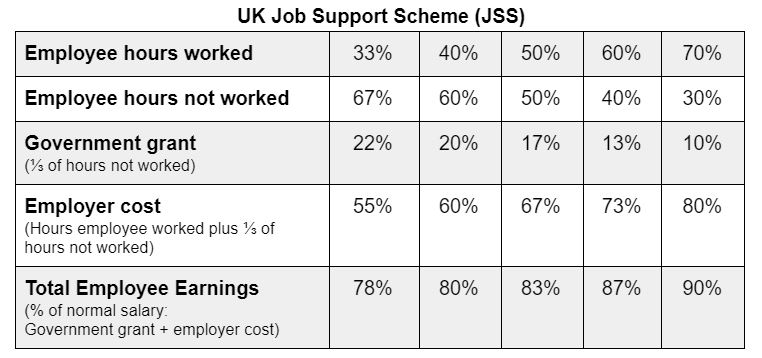As the virus resurges, the UK government has announced measures to continue financial support to businesses and employees affected by the pandemic. The newly announced Job Support Scheme (JSS) will replace the current Coronavirus Job Retention Scheme from November 1st, 2020.

The Coronavirus Job Retention Scheme which allowed employers to claim wages for employees on furlough was due to end on October 31st. Due to the ongoing crisis, the government has replaced the scheme with the Job Support Scheme (JSS), which is a slightly less generous version of the original scheme.
In this article, I will outline the eligibility to claim wages under the new scheme, the amounts paid by both the employer and the government, and how to make a claim.
What is the Job Support Scheme (JSS)?
The Job Support Scheme is a financial grant opportunity brought in by the UK government to help businesses retain employees during this unprecedented time. The scheme will start on November 1st 2020 and run for 6 months until April 30th 2021.
The goal of the scheme is to protect ‘viable jobs’ in companies who are experiencing decreased activity during the wintertime due to the pandemic. This will help employers remain in business, and employees keep their jobs.
Employees who are working a minimum of 33% of their normal working hours will be paid by their employer for the hours worked. Both the employer and the government will then pay out a third of the hours not worked. Therefore, the employee is guaranteed at least 77% of their standard salary.
Eligibility for the Job Support Scheme (JSS)
The government is continuously releasing new information surrounding the scheme, but have already revealed the eligibility for both employers and employees to take advantage of the grant.
Eligibility for employers
Under the rules of the new Job Support Scheme, employers must:
- Have a UK bank account
- Have a UK PAYE scheme
- Be a small or medium-sized business
- If you are considered a large business, you must be able to prove financial losses due to the pandemic and complete a financial assessment test
Your businesses previous use of the Coronavirus Job Retention Scheme does not affect your eligibility for the new scheme.
Eligibility for employees
To be eligible for the Job Support Scheme, employees must:
- Have been on the employer’s payroll prior to September 23rd 2020
- Must work at least 33% of their normal working hours (may be changed after 3 months)
Employees will not be required to stay on the scheme for the entire 6 months. They can cycle on and off the scheme where required. However, each period of reduced hours must cover a minimum of 7 days.
How much is the grant?
The grant provided by the government will be based on the employee’s standard salary. The government will provide one-third pay of the hours not worked by the employee. The employer will also contribute one-third of the hours not worked, along with the pay for the hours the employee did work.
The maximum government contribution will be £697.92 per month. The amount will still be taxed as normal for income tax and national insurance contributions.
Below, you’ll find a chart depicting how the breakdown of the costs will work under the Job Support Scheme.

How to make a claim for the Job Support Scheme
The scheme will commence on November 1st 2020, but the government payouts will be in arrears starting from December. This means that an employer can only submit a claim once the employee has already been paid out and the payment has been reported to HMRC.
You can easily make a claim through gov.uk and the payments will be received on a monthly basis.
HMRC will be checking these claims and require reimbursement if any of the information is incorrect or fraudulent.
Example of the Job Support Scheme (JSS)
Janice works for a company that is experiencing reduced sales due to the pandemic. She normally works a 40 hour, 5 day week and earns £500 per week. Instead of making Janice redundant, the business decides to put her on the Job Support Scheme. She will now work 3 days per week, which is 60% of her normal hours.
- Janice works 60% of her normal hours, and will not be working 40% of her normal hours
- Her employer will pay her 73% of her normal salary (60% + 13% which is one-third of 40)
- The government will contribute 13% of her normal salary (1/3rd of hours not worked)
- Therefore, Janice will only be working 60% of her normal hours but will earn 86% of her normal pay, which is £430 per week
The employer will pay Janice 86% of her normal salary on payday. Once payroll has been submitted to HMRC, the employer will submit a claim to be reimbursed the 13% government contribution.
Summary - Job Support Scheme
This new scheme will help businesses retain employees on a reduced schedule and ensure that employees will not be made redundant. The scheme may change during the course of the 6 months in regards to minimum working hours and maximum government contributions.
To find the most up to date information and guidance on the Job Support Scheme, I recommend visiting the UK government website.
If you want to learn more about other grants and schemes outlined in the Winter Economy Plan, check out our blog: 'Winter government support for small businesses and the self-employed'.
